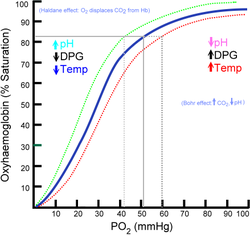Bohr effect
The Bohr effect describes the dependence of the saturation of hemoglobin on changes in CO2 concentration, pH, and temperature in tissues. The tissues produce higher amount of carbn dioxide at work than under resting conditions. In the blood, CO2 is converted to bicarbonate anion and hydrogen cation. This leads to a decrease of pH in tissues and to an increase in the desaturation of hemoglobin (the release of oxygen from binding with Hb). This is due to the fact that deoxygenated Hb is a stronger baze than an oxygenated one and therefore better accepting of H+.
HbO2 + H+ O2 + HHb+
Carbonate dehydratase in erythrocytes catalyzes the reaction: CO2 + H2O H2CO3 H+ + HCO3-. The resulting proton binds to the "less acidic" deoxygenated Hb. Bicarbonate anion escapes along the concetration gradient from erythrocytes.
The charge compensation is provided by antiport Cl-/HCO3- (Hamburgerův efekt).
This mechanism ensures that tissues with high metabolic activity receive a preferential supply of oxygen, while allowing the removal of the acidic proton.
References[edit | edit source]
Related articles[edit | edit source]
- Binding of oxygen to hemoglobin
- Hemoglobin and its derivatives
- Transport of O2 and CO2 in the blood
- 2,3–bisfosfoglycerát
External references[edit | edit source]
- Bohr effect [1]
Bibliography[edit | edit source]
- LEDVINA, M, et al. Biochemie pro studující medicíny II. 2. edition. Praha : Nakladatelství Karolinum, 2005. 275 pp. ISBN 978-80-246-1415-1.
- KITTNAR, Otomar, et al. Lékařská fyziologie. 1. edition. Praha : Grada, 2003. 790 pp. ISBN 978-80-247-3068-4.


